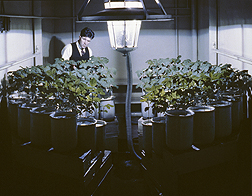ACS Names Beltsville Agricultural Research Center as National Historic Chemical Landmark
By Kim Kaplan
October 21, 2015
BELTSVILLE, Maryland, Oct. 21, 2015 — The discovery of phytochrome by scientists at the U.S. Department of Agriculture's Beltsville Agriculture Research Center (BARC) was honored as a National Historic Chemical Landmark by the American Chemical Society (ACS) today. Phytochrome is recognized as one of the universal regulators of plant physiology and growth.
It took a 41-year hunt from 1918 to 1959 to identify this pigment-containing protein, which the BARC team named phytochrome. Red light switches phytochrome to a biologically active form, while far red light reverses it to a biologically inactive form, a process that controls germination, growth and flowering.
"Phytochrome was one of the most important discoveries in plant science of the 20th century, making possible many valuable leaps forward for agricultural science, such as growing crops in new seasons and latitudes and even creating new ways to protect plants from pests," said Agricultural Research Service (ARS) Administrator Chavonda Jacobs-Young at a ceremony to mark the award. BARC is part of ARS, USDA's chief intramural scientific research agency.
For example, knowledge of phytochrome, and related photoperiodism, enabled soybean varieties to be bred to mature at staggered dates, boosting the value and importance of soybeans as a crop.
Awareness of phytochrome also brought the discovery that exposing chrysanthemums to light for just minutes in the middle of night prevents flowering. This allowed growers to time blooming, and turned mums into one of the country's most valuable ornamentals with U.S. sales of more than $135 million a year.
"The discovery of phytochrome explains how plants germinate, grow and flower in predictable cycles over the course of a year," said Pat N. Confalone, chair of the ACS Board of Directors. "This extraordinary collaboration between physiologists, biologists, chemists and other scientists at USDA demonstrates the importance of federal research in the fundamental sciences to unlock nature's most powerful mysteries." ACS, the world's largest scientific society, founded the National Historic Chemical Landmarks program in 1992 to recognize important milestones in chemical research.
The ceremony to mark this honor was followed by a symposium hosted by BARC on past, present and future research related to phytochrome. The keynote speaker was Peter H. Quail, professor, Department of Plant and Microbial Biology, University of California, Berkeley and research director of the Plant Gene Expression Center, Albany, California. His talk was titled A Pigment of the Imagination. Also speaking was Karl Norris, a member of the original ARS phytochrome discovery team and the developer of near-infrared reflectance spectroscopy, which can quantify the chemical composition of substances using certain light wavelengths.

